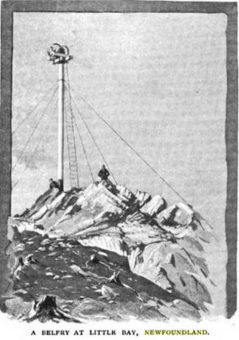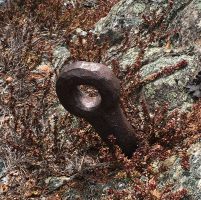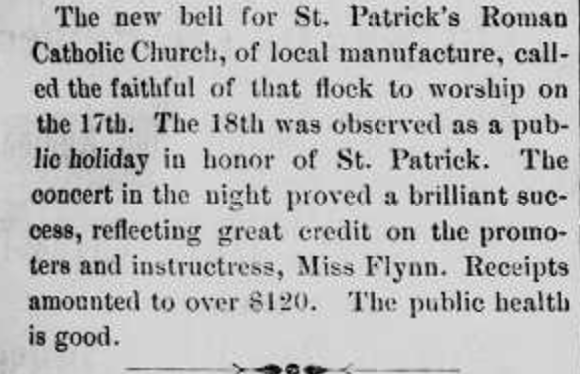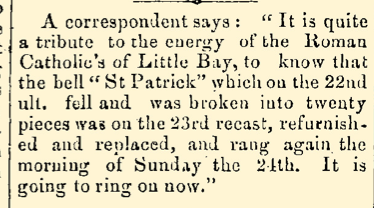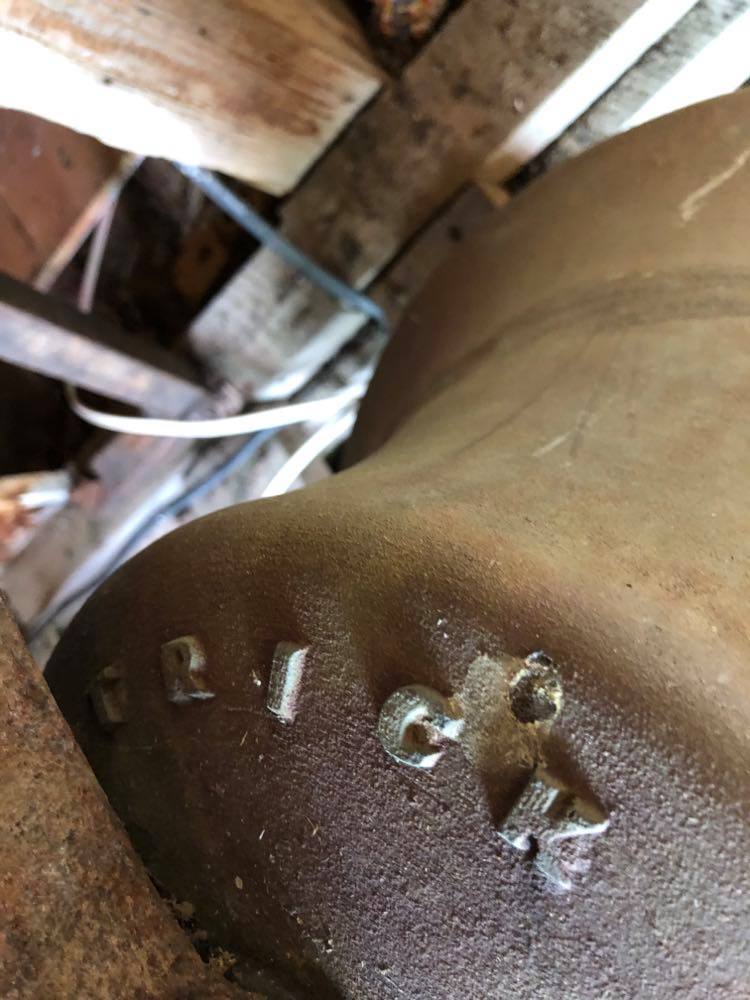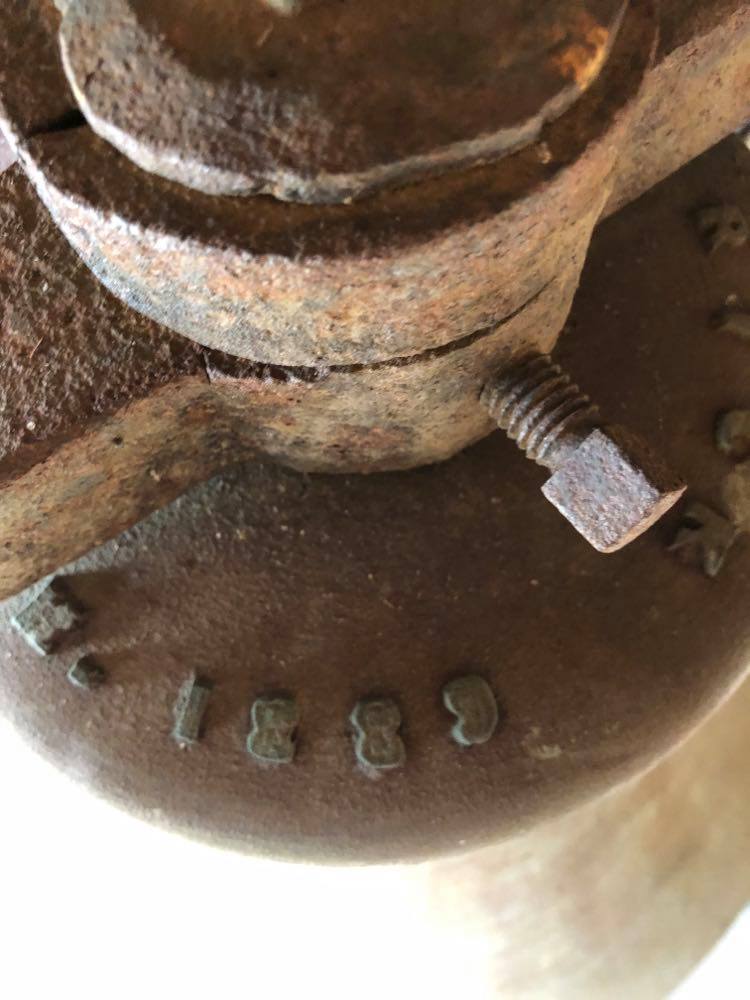Culture is made physical by the things we create. There is nothing quite like the history of an object. Artifacts connect us to a history that we can touch, see, and hear. Much of Little Bay’s physical history was lost to the fires but some historical objects are tucked away there still. They wait patiently to be rediscovered and explored. What follows is the history of such an object. Little Bay saw incredible growth immediately after it was founded in 1878 and by 1881 the Presbyterian Germans were outnumbered by a rapid influx of Newfoundland born Catholics. They came seeking well paid work in the mine. The Catholic working class made their home in an area of Little Bay called St. Patrick’s.
Today, St. Patrick’s is its own town and there’s a bell in the Roman Catholic church there with a fitting name: it’s called St. Patrick. It was not named for the town it resides in, but for the day of its creation, as it was manufactured in Little Bay on St. Patrick’s Day in 1889. The bell was likely named by the same man who’d named St. Patrick’s, the Reverend Stephen O’Flynn. St. Patrick first hung in Little Bay from the belfry outside of Her Lady of Carmel Parish. It overlooked an area of the town called ‘the Bight’ from its perch atop the hill. The black iron eyebolts that anchored it can still be found there by anyone willing to make the climb.
One of my favourite sources on Little Bay comes from an American boy’s adventure magazine from the 1890s. It contains an article by a man named Gustav Kobbe. Kobbe is remembered for his work on opera but at the time he was an adventurer who travelled to remote locations and wrote of frontier experiences. In his article I found the drawing of the belfry. Another great source on the bell comes from the Hayes family. Rick Hayes submitted a student interview conducted with his grandfather Leo Hayes in the 1980s. According to Leo Hayes the bell was the only thing to survive the fire in 1903 which destroyed the church. The last person buried in the RC cemetery in Little Bay was in 1961 which is around the time the church was built in St. Patrick’s. The bell was likely moved at this time. It has rarely been seen in the half century since.
I have the privilege to include pictures of St. Patrick at the end of this article because of Little Bay’s fire chief, Steve Walker, who recently had the opportunity to climb up into the steeple. On the bell is written L.B. Mar. I thought L.B. Mar might be the name of its blacksmith. The bell would have been created by first making a model of it out of wood. The wooden model was then filled with sand. This made an impression of the bell for the molten metal. The bell had fallen and been broken into 20 pieces just one month after it was forged. As the bell was broken almost immediately they would still have had the original model so it seems the blacksmith simply used it again. The writing on the bell was part of the wooden model, so it kept Mar despite being reformed in April. L.B. was therefore (now obviously) Little Bay; the location of its founding. It’s a little embarrassing how long it took to figure that out but that explains not only why it reads Mar and not April but also why the letters appear in varied fonts. The letters were individually crafted for the blacksmith.
I can place several blacksmiths in Little Bay during this period – not surprisingly none of them were named L.B. Mar! William Ross was the town’s blacksmith in 1885 according to the supreme court documents and between 1891 and 1900 I have references to two blacksmiths; James Albert Sheppard and Duncan Parsons. However, I can place only one blacksmith in Little Bay in 1889. His name was John Conway and he is the most likely candidate for the bellfounding of St. Patrick. John Conway died the following year after a suspiciously threatening letter to the editor which mentioned a very sharp axe. I can’t say for certain that he was murdered but it seems a possibility. He is survived by his creation.
The townsfolk tossed silver and copper coins from their own pockets into the molten metal that became St. Patrick. I quite like the image of this as it puts the living heart of the town into the making of the bell. The bell was an extension of the town. According to oral history it could be heard over ten miles away. It lifted the voice of the town across the vast and empty distances to comfort returning prospectors who’d worked away in isolation for long and lonely months. St. Patrick was made in Little Bay in March of 1889, it was quickly broken into pieces, and then remade the following month. It hung from a belfry in Little Bay before eventually ending up in St. Patrick’s where it resides still. It is likely the work of the blacksmith John Conway.
That’s the history of the bell named St. Patrick. I hope you enjoyed this piece. It was nice to write about something that wasn’t lost to the fires. I feel fortunate to be able to explore an artifact from Little Bay’s past that still exists today. Physical objects give a living weight to the culture and remind us that the past is still here with us now. I owe a big thanks to Rick Hayes and Steve Walker for submitting the material which lifted this piece above my archival sources. And thanks go to my dad for helping me figure out the embarrassing mystery of L.B. Mar by explaining how bells were made. He’s a wealth of knowledge that one. If you’d like to donate to this project you can find my Patreon here and if you’ve enjoyed this all the way to the end — give it a share. As always, thanks for reading!

